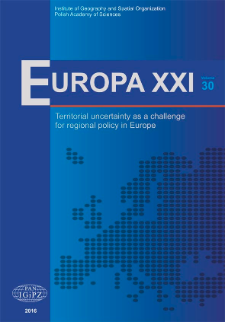- Search in all Repository
- Literature and maps
- Archeology
- Mills database
- Natural sciences
Advanced search
Advanced search
Advanced search
Advanced search
Advanced search

Object
Title: Cohesion of the European regional space
Subtitle:
Publisher:
Place of publishing:
Description:
Każdy numer posiada własny tytuł.
Type of object:
Abstract:
The purpose of the EU cohesion policy is to reduce disparities at the level of economic, social and spatial development of the underdeveloped regions. The Europe 2020 Strategy establishesmore growth- and innovation-oriented investments. The main objective of this paper is to analyze and evaluate the differences and dynamics of the EU regions at the NUTS 2 level, characterized by the selected variables in the economic, social and territorial accessibility (transport infrastructure) area to determine the clusters of different levels of disparities in the EU regions (HDI) and transport infrastructure as well as to examine their interdependence. Calculations were based on statistical data acquired from Eurostat databases. The results confirm a distinctively clear inequality of economic development in the European regional space between Central and Eastern Europe as well as Northern and Western Europe regions, with the highest growth of dynamics identified in the regions of the countries that joined the EU in 2007 and 2004. The analysis also identifies the European regions with a high level of spatial cohesion (accessibility) and validates the thesis about the presence of interdependence between the EU regional development and spatial cohesion (accessibility) of the regions.
References:
1. Agenda Terytorialna Unii Europejskiej 2020, 2011. www.vati.hu/territorialagenda /TA2020_PL.doc [1 October 2015].
2. Gorzelak G., 2007. Polityka spójności Unii Europejskiej: od entuzjazmu do wątpliwości.Opolskie Roczniki Ekonomiczne, vol. 17, Opole: Polskie Towarzystwo Ekonomiczne.
3. Gorzelak G., 2009. Uwagi nt. dokumentu UE Green Paper on Territorial Cohesion Turning teritorial diversity into strength [in:] A. Baucz, M. Łotocka, P. Żuber (eds.) Spójność terytorialna wyzwaniem polityki rozwoju Unii Europejskiej. Polski wkład w debatę, Warszawa: Ministerstwo Rozwoju Regionalnego.
4. Grosse T.G., 2008. Czy polityka spójności może być bardziej innowacyjna? Samorząd Terytorialny, vol 6.
5. INTERCO, 2011. Indicators of territorial cohesion.
6. ESPON, https://www.espon.eu /export/sites/default/Documents/Projects/ScientificPlatform/Interco/INTERCO_DFR_Main-Report.pdf [1 October 2015].
7. European Commision, 2014. Inwestycje na rzecz wzrostu gospodarczego i zatrudnienia. Szósty raport na temat spójności gospodarczej, społecznej i terytorialnej. http://ec.europa.eu/regional_policy/sources/docoffic/official/reports/cohesion6/6cr_pl.pdf, [1 October 2015].
8. Proniewski M., 2012. Rozwój regionów peryferyjnych w Unii Europejskiej. Białystok: Uniwersytet w Białymstoku.
9. Strahl D., 2003. Spójność ekonomiczna regionu Dolnego Śląska, Vedecka Pojednani – Wissenschaftliche Abhandlungen, Prace Naukowe, Liberec, vol. IX.
10. Szlachta J.,2011. Polityka Spójności Unii Europejskiej po kryzysie [in:] Z. Strzelecki (ed.) Gospodarka regionalna Polski wobec globalnego kryzysu gospodarczego, Warszawa: SGH.
11. Szlachta J., 2011. Spójność terytorialna traktatowym wymiarem polityki strukturalnej Unii Europejskiej. Prace i materiały instytutu rozwoju gospodarczego, Warszawa.
12. Szlachta J., 2012. Strategia Europa 2020 a europejska polityka spójności po 2013. http://kolegia.sgh.waw.pl/pl/KAE/struktura/IRG/publikacje/Documents/pim88_9.pdf [1 October 2015].
13. TERCO, 2012. European Territorial Co-operation as a Factor of Growth, Jobs and Quality of Life, Main Report. ESPON, http://www.esponterco.eu/media/raporty/terco_ final_report_main_report.pdf [1 October 2015].
14. Zaucha J., Komornicki T., 2010. Spójność terytorialna, jako proces integrowania polityki rozwoju wobec terytorium, Sopot: Instytut rozwoju http://www.instytut-rozwoju.org/WP/IR_WP2014_03.pdf [1 October 2015].
15. Zielona księga w sprawie spójności terytorialnej, 2008. Bruksela http://ec.europa.eu/regional_policy/archive/consultation/terco/paper_terco_pl.pdf [1 October 2015].
Relation:
Volume:
Start page:
End page:
Detailed Resource Type:
Format:
File size 4,1 MB ; application/pdf
Resource Identifier:
oai:rcin.org.pl:61352 ; 1429-7132 ; 10.7163/Eu21.2016.30.2
Source:
CBGiOŚ. IGiPZ PAN, call nos.: Cz.6406, Cz.6407 ; click here to follow the link
Language:
Rights:
Terms of use:
Copyright-protected material. May be used within the limits of statutory user freedoms
Digitizing institution:
Institute of Geography and Spatial Organization of the Polish Academy of Sciences
Original in:
Projects co-financed by:
European Union. European Regional Development Fund ; Programme Innovative Economy, 2010-2014, Priority Axis 2. R&D infrastructure
Access:
Object collections:
- Digital Repository of Scientific Institutes > Partners' collections > Institute of Geography and Spatial Organization PAS (IGiPZ PAN) > Publications of IGiPZ PAN and employees
- Digital Repository of Scientific Institutes > Partners' collections > Institute of Geography and Spatial Organization PAS (IGiPZ PAN) > Library > Series/Journals/Periodics
- Digital Repository of Scientific Institutes > Literature > Journals/Articles
Last modified:
Oct 13, 2023
In our library since:
Dec 27, 2016
Number of object content downloads / hits:
707
All available object's versions:
https://rcin.org.pl./publication/80453
Show description in RDF format:
Show description in RDFa format:
Show description in OAI-PMH format:
| Edition name | Date |
|---|---|
| Proniewski M. - Cohesion of the European regional space | Oct 13, 2023 |
Objects Similar
Costa, Eduarda Marques da Palma, Pedro Rauhut, Daniel Humer, Alois Constantin, Daniela Velasco Echeverria, Xabier
Michniak, Daniel
Degórska, Bożena (1956– )
Komornicki, Tomasz
Epasto, Simona
Meier-Dallach, Hans-Peter Heinickel, Gunter

 INSTYTUT ARCHEOLOGII I ETNOLOGII POLSKIEJ AKADEMII NAUK
INSTYTUT ARCHEOLOGII I ETNOLOGII POLSKIEJ AKADEMII NAUK
 INSTYTUT BADAŃ LITERACKICH POLSKIEJ AKADEMII NAUK
INSTYTUT BADAŃ LITERACKICH POLSKIEJ AKADEMII NAUK
 INSTYTUT BADAWCZY LEŚNICTWA
INSTYTUT BADAWCZY LEŚNICTWA
 INSTYTUT BIOLOGII DOŚWIADCZALNEJ IM. MARCELEGO NENCKIEGO POLSKIEJ AKADEMII NAUK
INSTYTUT BIOLOGII DOŚWIADCZALNEJ IM. MARCELEGO NENCKIEGO POLSKIEJ AKADEMII NAUK
 INSTYTUT BIOLOGII SSAKÓW POLSKIEJ AKADEMII NAUK
INSTYTUT BIOLOGII SSAKÓW POLSKIEJ AKADEMII NAUK
 INSTYTUT CHEMII FIZYCZNEJ PAN
INSTYTUT CHEMII FIZYCZNEJ PAN
 INSTYTUT CHEMII ORGANICZNEJ PAN
INSTYTUT CHEMII ORGANICZNEJ PAN
 INSTYTUT FILOZOFII I SOCJOLOGII PAN
INSTYTUT FILOZOFII I SOCJOLOGII PAN
 INSTYTUT GEOGRAFII I PRZESTRZENNEGO ZAGOSPODAROWANIA PAN
INSTYTUT GEOGRAFII I PRZESTRZENNEGO ZAGOSPODAROWANIA PAN
 INSTYTUT HISTORII im. TADEUSZA MANTEUFFLA POLSKIEJ AKADEMII NAUK
INSTYTUT HISTORII im. TADEUSZA MANTEUFFLA POLSKIEJ AKADEMII NAUK
 INSTYTUT JĘZYKA POLSKIEGO POLSKIEJ AKADEMII NAUK
INSTYTUT JĘZYKA POLSKIEGO POLSKIEJ AKADEMII NAUK
 INSTYTUT MATEMATYCZNY PAN
INSTYTUT MATEMATYCZNY PAN
 INSTYTUT MEDYCYNY DOŚWIADCZALNEJ I KLINICZNEJ IM.MIROSŁAWA MOSSAKOWSKIEGO POLSKIEJ AKADEMII NAUK
INSTYTUT MEDYCYNY DOŚWIADCZALNEJ I KLINICZNEJ IM.MIROSŁAWA MOSSAKOWSKIEGO POLSKIEJ AKADEMII NAUK
 INSTYTUT PODSTAWOWYCH PROBLEMÓW TECHNIKI PAN
INSTYTUT PODSTAWOWYCH PROBLEMÓW TECHNIKI PAN
 INSTYTUT SLAWISTYKI PAN
INSTYTUT SLAWISTYKI PAN
 SIEĆ BADAWCZA ŁUKASIEWICZ - INSTYTUT TECHNOLOGII MATERIAŁÓW ELEKTRONICZNYCH
SIEĆ BADAWCZA ŁUKASIEWICZ - INSTYTUT TECHNOLOGII MATERIAŁÓW ELEKTRONICZNYCH
 MUZEUM I INSTYTUT ZOOLOGII POLSKIEJ AKADEMII NAUK
MUZEUM I INSTYTUT ZOOLOGII POLSKIEJ AKADEMII NAUK
 INSTYTUT BADAŃ SYSTEMOWYCH PAN
INSTYTUT BADAŃ SYSTEMOWYCH PAN
 INSTYTUT BOTANIKI IM. WŁADYSŁAWA SZAFERA POLSKIEJ AKADEMII NAUK
INSTYTUT BOTANIKI IM. WŁADYSŁAWA SZAFERA POLSKIEJ AKADEMII NAUK


































